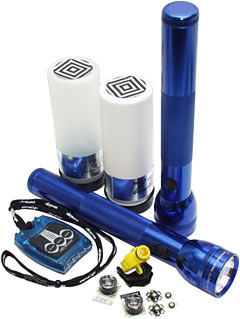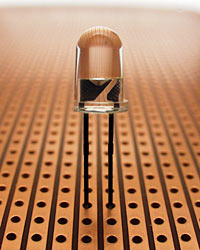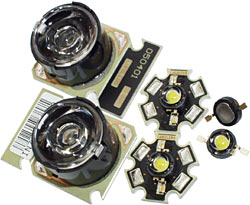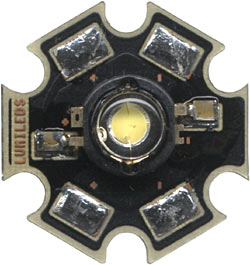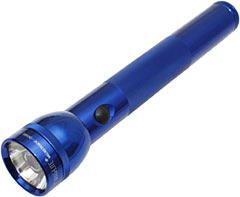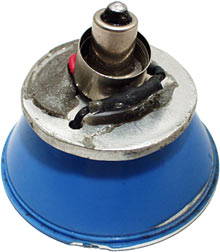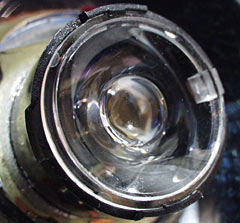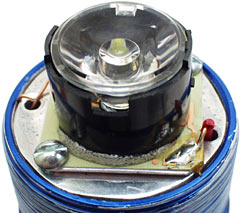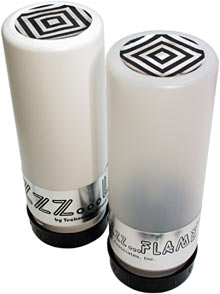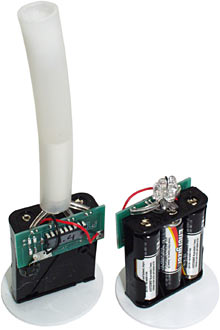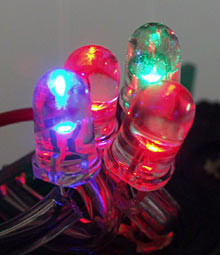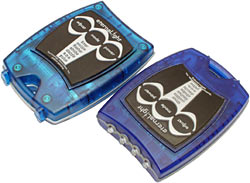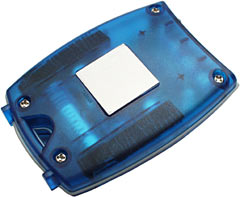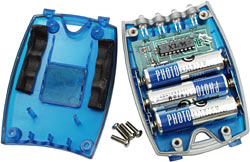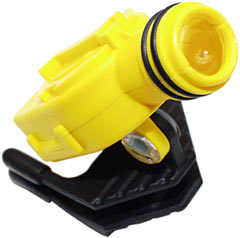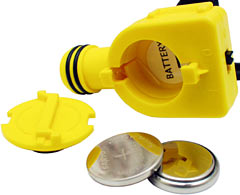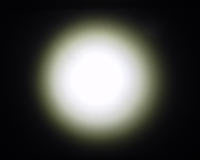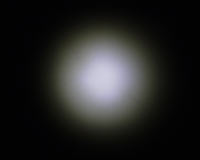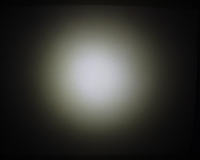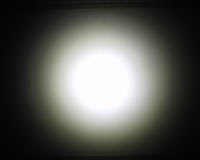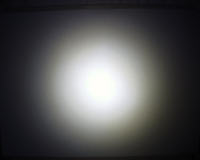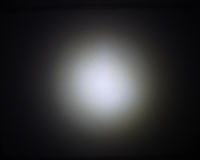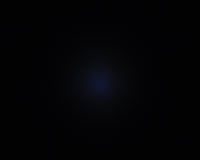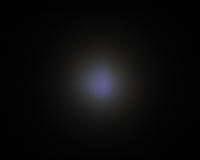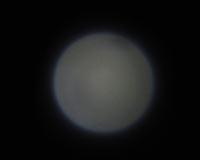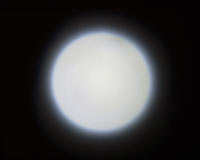
LED light roundup: Elektrolumens modified flashlights, Luxeon Star lamps, Technology Associates EliteXRay and Zzz...Lites, QED Bil-Lite
Review date: 9 April 2002.Last modified 03-Dec-2011.
Light Emitting Diodes (LEDs) need to be cheaper, and they need to be brighter, if they're to be useful for general lighting purposes.
So that's what's happening, right now.
When most people think of an LED, they think of something that looks like this.
You can, by the way, buy a T-shirt with that image on it. But I digress.
There are two problems with plain 5mm high intensity LEDs like the one in the above picture. One, they have a very small light emitting "die"; two, they have a lousy heat path out of that die.
There are limits to how much light per unit area you can get out of a given LED's die; the more you wring out of it, the more heat it'll produce. The main cooling path for an LED like this is conduction down the metal leads; the solid epoxy lens is a pretty good thermal insulator.
In little pocket flashlights, single high intensity 5mm LEDs work better than incandescent globes already. The Arc-AAA I review here goes with me everywhere, and beats the heck out of the Mag-Lite Solitaire it resembles. The Arc's lamp is drawing about only a tenth of a watt, but for a baby light that runs from a single AAA cell, that's lots.
Unfortunately, LEDs like the ones in the Arc-AAA and most other LED flashlights don't scale. If you want to use LEDs to get the light output of a normal flashlight globe, let alone a household light bulb, you can't just turn up the juice. You need to use multiple LEDs.
There are some pretty bright flashlights that use an array of LEDs, but each of those LEDs costs at least $US2 wholesale, and assembling them into a lamp isn't free either. Flashlights like the Lightwave 3000 and 4000 (reviewed here) aren't as bright as similar sized incandescent models, but they cost $US50 and up - and the Lightwaves are cheap by large LED flashlight standards.
LED light bulbs for mains power applications also exist, but they're ludicrously expensive, and don't produce anything like the brightness of a plain old hundred watt globe.
LEDs give you excellent performance from nearly-dead batteries. White ones deliver a smooth pool of clean white light. They're shockproof, and they're good for tens of thousands of hours of operation if they're not overdriven.
But in pure brightness-per-dollar terms, they're not up there with filament globes yet.
They will be, though.
These widgets represent a significant step along that path. They're Lumileds Luxeon lamps - single, ready-to-connect LEDs that offer about ten times the brightness of regular high intensity units.
Lumileds (a joint venture of Philips Lighting and Hewlett-Packard spin-off Agilent) have figured out how to make LEDs with larger emitter areas and better heat sinking. Result - more output capacity.
The four bigger objects in the picture are Luxeon Star lamps, which come on a metal-backed square or hexagonal submount that provides heat sinking for the LED.
This is necessary because the Luxeon lamps, like other LEDs, aren't perfectly efficient. Run them at high power, and they get hot. The hotter they get, the more current they'll pass, all things being equal, which allows them to get even hotter. This "thermal runaway" is apt to end in tears, and LED power supplies have to have some in-line resistance somewhere to stop it from occurring. That doesn't stop the LED from blowing up if you just ramp up the supply voltage willy-nilly, though.
The LEDs with the lenses on top in the above picture are "Star/O" lamps. The lenses are made of polymethylmethacrylate ("PMMA", the same stuff used for hard contact lenses; you probably don't care about that, but I took the time to look it up and so I'm darn well going to tell you) and they give the lamps a reasonably tightly collimated beam, useful for flashlights. The Star/O circuit board is actually square, but the lamps come with an extra snap-off tab on the side of the board, which I left on for this picture.
The Stars on the snowflake-ish boards are the Hex model. They've got four solder pads per module, versus two for the Star/O, which makes them easier to assemble into big arrays for relatively high power diffuse lighting. The Hex LEDs have a metal backed circuit board, too; the boards by themselves provide decent heat sinking, and it's easy to bond them to a bigger chunk of metal for better cooling.
The little things to the right of the bigger modules are a pair of plain "Emitters", which have no heat sink and need to be attached to one if you want to run them at much more than normal LED brightness.
All of these LEDs light up white, which is why they look yellow in the middle; the yellow stuff is a phosphor layer on top of a blue LED die. No un-phosphored LED can produce more than a very small band of wavelengths.
Lumileds also make Luxeon lamps in all the other usual LED colours - red, amber, green, and different shades of blue.
For all of the Luxeon models, you're talking $US12 to $US15 per unit retail, from people like Arc Flashlight or Mark Hannah Surplus. That's expensive, for an LED - but it's only about four times the price of a normal high intensity 5mm epoxy-packaged white LED. And the Luxeon is ten times as bright, at least.
How much light you'll get out of a Luxeon lamp depends on how hard you drive it. It's apparently possible to overdrive the current Luxeons to three or four watts, but that's not a great idea. According to the specifications, the absolute maximum power for current white Luxeons is about 1.4 watts - 350 milliamps (mA) current at 3.99 volts.
Higher power LEDs are coming from Lumileds and Nichia; for the time being, one watt is as much as it's wise to ask for without much better heat sinking than the standard Star circuit boards provide.
Since white LEDs are only about as efficient as halogen incandescent lamps, one watt - or two - is not enough for home lighting. Emergency lighting, yes. Close-up desktop task lights, also yes. Light bulb replacement, no.
One watt's not too bad for a flashlight, though.
I'm reliably informed that most people don't want to buy bare LEDs and assemble their own light. They want to buy something that you just stick batteries in and use.
Arc Flashlight use Luxeon lamps in their Arc-LS light, but they've been selling all of those that they can make, and so haven't had a spare one to send me for review.
Someone else did, though.
At a glance, you'd think this was a three-D-cell Mag-Lite. And you'd be right. It was.
What it is now is a Luxeon-powered light. The standard Mag bulb's been removed and replaced with a Star/O emitter, by Elektrolumens.
Wayne Johnson at Elektrolumens is, as I write this, retrofitting various lights with Luxeon lamps, and assembling a few flashlights of his own. He sent me two modified Mag-Lites; if they're anything to go by, he's got the makings of a decent little business here. You can buy Elektrolumens lights direct on Wayne's site; the modified lights cost around $US50.
The reflectors in the flashlights I got are still there, with a bigger hole in the middle, to accommodate the LED. They don't do much any more, though, because there's very little sideways light spill from a Star/O.
The new lamp also makes it impossible to focus the flashlight in the normal Mag-Lite twist-the-end way; this is a problem most LED lights have. As a proof of concept, though, these lights are just fine, and they work perfectly well.
The two Elektrolumens lights I got to play with look exactly the same, but behave differently. One of them takes only two D cells, with the third battery's spot in the tube taken by a step-up voltage regulator. This increases the flashlight's cost and reduces its battery life, but means it'll stay closer to its full brightness for the whole life of the batteries.
The other flashlight uses the normal three cells, and has a simple resistor in-line with the lamp to limit its current and keep thermal runaway at bay. Cheaper, longer battery life...
...and a neater lamp installation job; Wayne made this light after the two-cell one. But it does have dimmer output than the two-cell light, as its batteries go flat.
From fresh batteries, both Elektrolumens lights have much the same brightness, but the three-cell one has a noticeably different puddle of light, as you'll see in the output-pictures section below. I'm inclined to attribute the difference to Lumileds; they don't seem to be managing perfect uniformity in their products. A bit of lens-calibration unevenness isn't likely to matter, though.
On that subject, there've been reports that newer Luxeon Stars are brighter than the earlier units. This sort of variation is par for the course in the cutting-edge LED market; brightness and exact colour tend to vary slightly between batches of white LEDs in general, and Luxeons are no exception.
As prototypes go, these two flashlights are great, and produce perfectly respectable output, as you'll see below. I wouldn't have any qualms about buying an Elektrolumens light. Well, OK, if I didn't already have a house full of LED lights, I wouldn't.
Lamps that use normal LEDs, mind you, are still far from useless. Which is good news for the people that're still sending them to me. Like, for instance, Technology Associates.
The colours! The colours!
I've checked out Technology Associates LED lights before, here and here, and in my very first LED light review here. They make a variety of nifty gear.
These, though, are new.
At first sight, the two models of "Zzz...Lite!", as Technology Associates insist on calling them, look not unlike plastic storage bottles standing on their lids, with a couple of decorative stickers.
Which, to be fair, they are; you can buy containers just like these at the supermarket.
Inside the containers, though, are these things.
On the left, the lamp from the white-cased Zzz...Lite; on the right, the four-bare-LEDs lamp assembly of the translucent-cased "Zzz...Flame". The tube on the Lite's LEDs eats some of the light, but it evens out the rest, and its white casing gives it a very consistent all-round glow. The Flame is quite a lot brighter, but you can clearly see the colour of the four LEDs though the case, which is unevenly illuminated by them.
Here the Flame lamp is, running without the case. One blue, one green, two red. Because red is less visible than the other colours, it needs a pair of LEDs.
To use either Zzz...thingy, you unscrew the lid, install three (un-included) AA cells in the battery holder, screw the light back together again, and then shake it once. There's a rolling-BB position switch that lets the light know when it's been shaken or inverted, and that's what turns it on.
After one shake, each light briefly runs all of its LEDs at full power, and then starts changing the intensity of each colour independently, and fairly smoothly. The result is a constantly changing "spectral candle" rainbow colour display, bright enough for use as a nightlight.
Which is rather difficult to photograph.
Here's part of the Flame's colour progression. The plain Zzz...Lite is more subtle.
You can download a video clip of the Zzzs doing their thing here; it's a Zip archive containing a Windows Media clip. If you're unable to play that format of video, the depth of my lack of concern for your problems is beyond human comprehension.
The clip was shot with an auto-white-balance webcam, which was doing funny colour balance things as the lights cycled their colours; you can see the colour of the backdrop changing. It's not too bad an illustration, though.
Both Zzz...Lites, left to their own devices, will cycle colours for about a quarter of an hour, getting dimmer and dimmer as they do it, and then turn themselves off. Ideal behaviour for a nightlight, provided you're not deathly afraid of the dark.
You can turn them off earlier by shaking them again, and you can lock them in full-on mode by shaking them five or more times, as long as you do it rapidly enough.
The plain Zzz...Lite has a creamy-dreamy look, with quite even illumination of its casing. The Zzz...Flame is a better choice for someone who already owns a UFO lamp and a lava lamp and a plasma globe, and wants another trippy light-toy. Which can be taken on a camping trip.
For $US29.99 (on special, as I write this, for $US24.99), the Zzz...Lites aren't dirt cheap, but they're pretty solidly made, they work well, and they're probably unlike anything you've ever seen before.
They're not exactly unique, though. Color Kinetics make a selection of "Sauce" colour-shifting LED light gadgets, including the LightSaucer. The Saucer's rather similar to the Zzz...Lites in concept, but can do some other tricks. It costs about the same, but I haven't played with one yet. If you want something that can (dimly) light up a room, the Zzz...Lites seem likely to work better than the rather directional LightSaucer, but I could be wrong.
XRay evolution
And then, there's this.
The EternaLight range is Technology Associates' main product line, and the Elite Series XRay is a recent addition. It's basically the same thing as the original $US49.99 "ErgoXRay", which I reviewed here.
The EliteXRay's the paler one.
Both lights have four white LEDs, three AA cells for power, three control buttons on top for their various modes, and a well-sealed pager/phaser shaped translucent case with single internal blue LED that can be set to glow constantly or pulse occasionally, so you can find the light. But the Elite Series adds some bells and whistles. As you'd want it to, since it costs $US79.99.
For your extra dollars, you get a magnet built into the underside of the light. It's more than strong enough to hold the EliteXRay's weight if you stick it to a flat magnetic metal surface. It's not powerful enough that you can hang the light from one nail-head, but that may be a good thing; rare earth magnets don't play well with others.
Unfortunately, the magnet's only held onto the case with double-sided tape; when I stuck the EliteXRay upside-down on a steel surface, the tape let go after a few hours. The magnet was still stuck fast to the steel, but the rest of the light was on the floor.
This can, of course, be fixed with a quick scrub to remove the tape and then the application of some more serious adhesive. You'll probably be wanting to do that before you're on top of a ladder in the middle of the night with your light stuck upside-down to the guttering next to your head.
The Elite case is held together with stainless steel screws that fit into threaded brass inserts, versus the non-stainless screws biting into plastic in the ErgoXRay. This means the EliteXRay ought to tolerate more battery replacements without the case loosening up - not that I think that's likely to happen too quickly anyway - and it should also deal better with abuse, including dunkings in seawater.
You also get a breakaway lanyard with the EliteXRay; it has a clip in its end loop that pops open when yanked firmly. You could hang it from something in your boat cabin and it'd never fall off, but would come with you when you grabbed it with authority.
The EliteXRay comes with batteries, like the other EternaLights, but they're lithium AAs, not the alkalines that come in almost all of the other models. The lithiums have a bit more capacity and shelf life, and their terminal voltage is a bit higher, which makes the light brighter from fresh batteries.
The major advantage of the lithiums, though, is that they make the EliteXRay light enough to float. It's not a dive light - nothing with pushbuttons deals well with water pressure - but it should work well in marine applications otherwise.
The Elite-series casing's got bigger feet on the back of it than the standard Ergo EternaLights, so it's easier to stand on its tail for ceiling-lighting candle duty. It's still not very stable, though, and you can't stand it up if the lanyard's attached.
You also get a little screwdriver with the EliteXRay, for taking the case apart. It proved inadequate to the task of removing the tightly fitted screws on the light I got for review, though. If you don't have a grip of steel, you'll need a bigger driver.
If you ask me, the best features of the EliteXRay are the ones it shares with the other EternaLights - the various microprocessor-controlled lighting modes. The most often used of these modes is the dimmer; you can turn the light down until only one LED is on, at greatly reduced brightness, giving at least a month of continuous operation from fresh batteries. Probably quite a lot more.
Minimum brightness is still enough for seeing where your feet are going at night, or reading; lots of flashlights are brighter than necessary for many jobs. Even if you don't care much about battery life, it's nice to be able to avoid ruining your night vision.
The EternaLight user interface isn't perfect. If you want one-LED mode, you turn the light on at full brightness, press Mode once, and then press Adjust twelve times to wind the brightness all the way down. But it's pretty easy to use, and you can also activate strobe and flasher and SOS and "dazzle" attention-getting modes, as described in my Ergo Eternalight review.
Whether the various new stuff in the Elite flavour of the XRay is worth $US30 is something I'm not sure about. If you want a more boat-compatible light, then it probably is. Otherwise, you'd probably do just as well with the plain XRay.
Bil-Liting
Need a light you can clip onto your baseball cap?
OK, you've probably never thought of clipping a light onto your baseball cap. But it's not a bad idea, really; a small, light LED lamp with a spring clip, which can be attached to any fairly thin object and angled to aim at whatever you're doing.
QED's Bil-Lite is that light. It's essentially the same thing as the various key-ring LED lights out there - one LED, two lithium coin cells powering it - but it's got some extras.
First up, of course, the clip. I'm not a baseball cap kinda guy, but there are other things you can clip the Bil-Lite to. The simple slide switch on the back makes it easy to operate when wrist-mounted.
(That wristwatch, by the way, is reviewed here.)
The second unusual thing about the Bil-Lite is its lens. The single white LED is well matched to this lens, to deliver a surprisingly neat and even circle of light. No hot spot in the middle, no big fringe around the edge. A near-perfect white full moon of quite respectable brightness, wherever you point the thing.
The Bil-Lite's sturdy little body has a rotating battery bay cap, and it's easy to get at the two coin cells. They're CR2032 lithiums, the heavyweights of the coin cell world, and they'll give the Bil-Lite considerably better battery life than the average teeny-light.
This still isn't a product that'll work for hours every day without pretty frequent battery changes, though. The constant-colour behaviour of the white LED means that lights powered by coin cells will deliver useable light even when their batteries are, for normal intents and purposes, dead flat; you could leave the Bil-Lite on for two or three days straight and still be able to read a map by its light. But if you can't tolerate greatly reduced brightness, you'll be replacing the batteries long before then.
That said, though, I like this product. For $US19.95 from the manufacturers' on-line store, the Bil-Lite isn't terribly expensive for what it is. It's solidly made, it's super-portable, and it definitely fills a need, for all sorts of people.
There's an improved Bil-Lite in the pipeline, apparently, with a 180 degree swivel mount so it can clip onto glasses and aim forward, and some other tweaks. The current one's already good, though.
Output
To test the brightness of these flashlights, I set up my usual test target - an A3 sheet of paper, long axis horizontal, 40cm away from my ISO-100-sensitivity digital camera, with its lens set to 36mm-equivalent, f2.8.
Here's the output from the two-cell Elektrolumens light, with a 1/20th second exposure.
...which I had to shorten to 1/80 to avoid overexposure.
At 1/80, this doesn't look too bright - but it's brighter than the 10-LED Lightwave 4000 I review here...
...and it's only a bit dimmer than this 1/80th second shot of the output from the rather expensive 14-LED Tektite dive light I review here.
The three-cell Elektrolumens light has slightly higher brightness from fresh batteries.
Here it is at 1/20...
...and this is 1/80. The hot spot in the middle is larger and hotter, the fringe around the edge is smaller, but it's much the same, really.
From fresh batteries, the two-cell light's regulator feeds the lamp 3.5 volts, which is on the low side for normal blue and white LEDs. The Luxeon Star lamps run from lower voltages than small high intensity LEDs, though, and they draw a lot more current. At 3.5 volts, this one sucks about 450 milliamps (mA), for a 1.575 watt power draw.
Once the edge was off the batteries - after only a few minutes of use - the regulator's output sagged to 3.4 volts, for about a 300mA current draw and little more than one watt of power. That's the power level the light was running at when I took the beam-shot picture.
One watt is a bit less than I expected; the Luxeon lamp does seem to be considerably more efficient than old-style LEDs, judging by the relative brightness in the beamshot pictures.
The three-cell Elektrolumens light was only getting about 3.3 volts from its batteries when I tested it after it had been on for a few minutes. At that voltage, the lamp draws around 355mA, for about 1.17 watts. Wound up to 3.5 volts from my bench supply, this flashlight's lamp draws more than 500mA; about 1.8 watts. That's noticeably different from the behaviour of the Luxeon in the other flashlight, and evidence of the inconsistent performance of these things. The lamp-to-lamp differences aren't likely to be a problem unless you're trying to make perfectly even decorator art lighting out of lines of Luxeons, or something, but it should be borne in mind. There does seem to be a quite significant amount of variation between Luxeon Stars of nominally identical spec.
Despite their amazing-by-LED-standards performance, these big D-cell torches still aren't amazing performers compared with normal flashlights. Useful? Yes. Worth owning? Sure. Great if you're a battery-scrimping environmentalist? Absolutely.
Obviously superior to the un-tweaked incandescent original, though? No.
They've got all of the LED advantages, but they're just not as bright. The standard 3-D cell Mag-Lite bulb's good for the thick end of three watts.
That's three yellow-tinted, unevenly-distributed watts, and it drains the batteries roughly four times as fast as the Luxeon lamps. But it's obviously brighter - especially if you want to view something at a distance, and focus the light down to do so.
Still, these things are obviously a big leap in LED technology. They're good now, and they're only going to get better.
Here's the EliteXRay's output at 1/20. Thanks to its lithium AAs, it's brighter than alkaline-powered EternaLights...
...and I actually needed to go to 1/40th to avoid overexposure. At full power, this light's more than bright enough for anything you're likely to want to do indoors (people who live in aircraft hangars may disagree), and it gives a very good account of itself for outdoor tasks too, considering its size. There's still no zoom, so you still won't see anything more than about ten metres away, but for most domestic flashlight purposes that doesn't matter.
Here, for comparison, is a 1/20th shot of the EliteXRay's minimum power output. It barely even shows up at this exposure setting.
At 1/5th, it's still pretty underwhelming. But, as I said, it's fine for close-up night-time tasks, assuming your night vision isn't too bad. Since the LED hasn't slid down into dark red uselessness like a super-dimmed incandescent globe, very low output levels remain useful.
Here's the Bil-Lite's spookily even output at 1/20th...
...and here it is at 1/5th.
This thing has the most even output I've ever seen from any flashlight. It's amazing. I don't know that it's actually massively more useful than the usual hot-middle sort of LED output, and the lens is doubtless eating some of the light (the lens on the Luxeon Star/O only passes 85% of the light from the die, according to Lumileds' specs), but the Bil-Lite nonetheless scores high points for sci-fi appeal. Useful beam width, perfectly OK brightness (from fresh batteries, anyway), extraordinarily smooth illumination.
Overall
None of these products are really competing with each other, so nobody wins in this comparison. All of them are good.
The Elektrolumens flashlights and their Luxeon-powered relatives are a glimpse of the future of lighting, and you can already get all but the fanciest Luxeon flashlights cheaper than multi-LED lights with inferior efficiency.
The EliteXRay (recently joined in the Technology Associates catalogue by an EliteMarine) isn't cheap, but it's the gold standard EternaLight; these things were already good, and now they really can't get much better.
The Zzz...Lites provide an excellent blend of fun and utility. They're equally at home in a toddler's bedroom or a party full of people who, for entirely legal reasons, have developed a sudden fascination with pretty lights.
And the Bil-Lite is a decently priced little gadget that's different enough from what's gone before to make it well worth buying.
So you could probably find a reason to buy all of these lights, if you tried hard enough.
Go on. Try.
